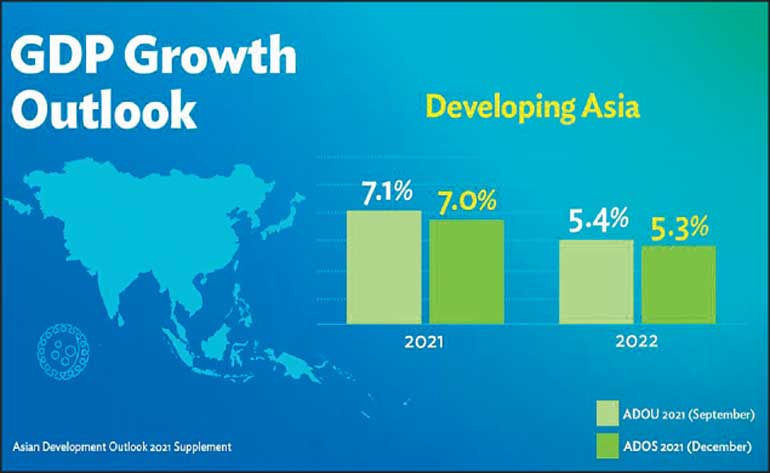Friday Jan 10, 2025
Friday Jan 10, 2025
Saturday, 18 December 2021 01:13 - - {{hitsCtrl.values.hits}}

The Asian Development Bank (ADB) this week revised its economic growth outlook for developing Asia down slightly to 7% this year and 5.3% next year, after renewed outbreaks of coronavirus disease (COVID-19) led to slower growth in the third quarter.
ADB’s latest estimates, presented in a regular supplement of the Asian Development Outlook (ADO) 2021, compare with the bank’s September forecasts of 7.1% growth for 2021 and 5.4% for 2022. Prospects for this year have been revised slightly downward for all subregions except Central Asia.
“Developing Asia’s steady progress in dealing with COVID-19, through continued vaccination drives and more strategic application of containment measures, helped boost growth prospects in the early part of the year,” said ADB Acting Chief Economist Joseph Zveglich Jr. “However, new outbreaks in the third quarter muted gross domestic product growth, and the advent of the Omicron virus variant is causing renewed uncertainty. Recovery efforts will have to take these developments into consideration.”
The main risk to the growth outlook remains a resurgence in COVID-19 cases. The average number of daily cases globally rose to almost 573,000 on 30 November from 404,000 on 15 October. Developing Asia’s vaccination rate has increased significantly to 48.7% (fully vaccinated) as of 30 November, although the region still lags behind the United States at 58.1% and the European Union at 67.2%. Rates of fully vaccinated people also vary widely within the region, from as high as 91.9% of the total population in Singapore to as low as 2.2% in Papua New Guinea.
Bucking the overall trend for developing Asia, Central Asia’s economy is expected to grow 4.7% this year, reflecting higher commodity prices and increased public spending. The forecast for next year has also been raised to 4.4% from 4.2% in September.
East Asia’s growth outlook has been downgraded by 0.1 percentage points for both 2021 and 2022, to 7.5% and 5.0%, respectively, amid slight downward adjustments in the forecasts for the People’s Republic of China (PRC)—the region’s largest economy. The PRC’s economy is now expected to grow 8.0% this year and 5.3% next year.
South Asia is forecast to grow 8.6% in 2021, compared with September’s forecast of 8.8%. The sub-region’s 2022 outlook remains at 7.0%. India, South Asia’s largest economy, is now expected to grow 9.7% in fiscal year (FY) 2021, which ends 31 March 2022. The reduction of 0.3 percentage points comes amid supply chain issues that are affecting industry. India’s outlook for FY2022 is maintained at 7.5%, as domestic demand is expected to normalise.
Southeast Asia’s 2021 outlook has been revised down by 0.1 percentage points to 3% as economies in the sub-region imposed targeted restrictions in the face of COVID-19’s Delta variant. Next year’s growth forecast is increased to 5.1% as economies are expected to continue easing overall restrictions and reviving economic activities. The growth forecast for the Pacific is maintained at -0.6% this year and revised slightly down to 4.7% for 2022.
Regional inflation is expected to remain manageable at 2.1% in 2021 and 2.7% in 2022, allowing for a more accommodative monetary policy and supporting pandemic recovery efforts.
ADO, ADB’s annual flagship economic publication, is published every April, with an Update published in September and brief supplements published normally in July and December. Developing Asia refers to the 46 developing members of ADB.
ADB is committed to achieving a prosperous, inclusive, resilient, and sustainable Asia and the Pacific, while sustaining its efforts to eradicate extreme poverty. Established in 1966, it is owned by 68 members — 49 from the region.